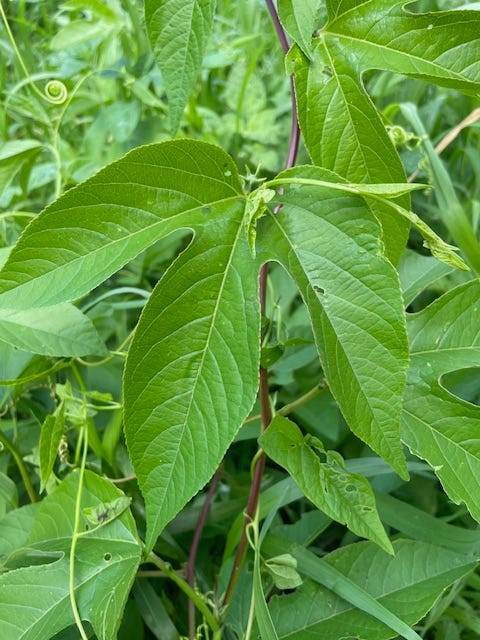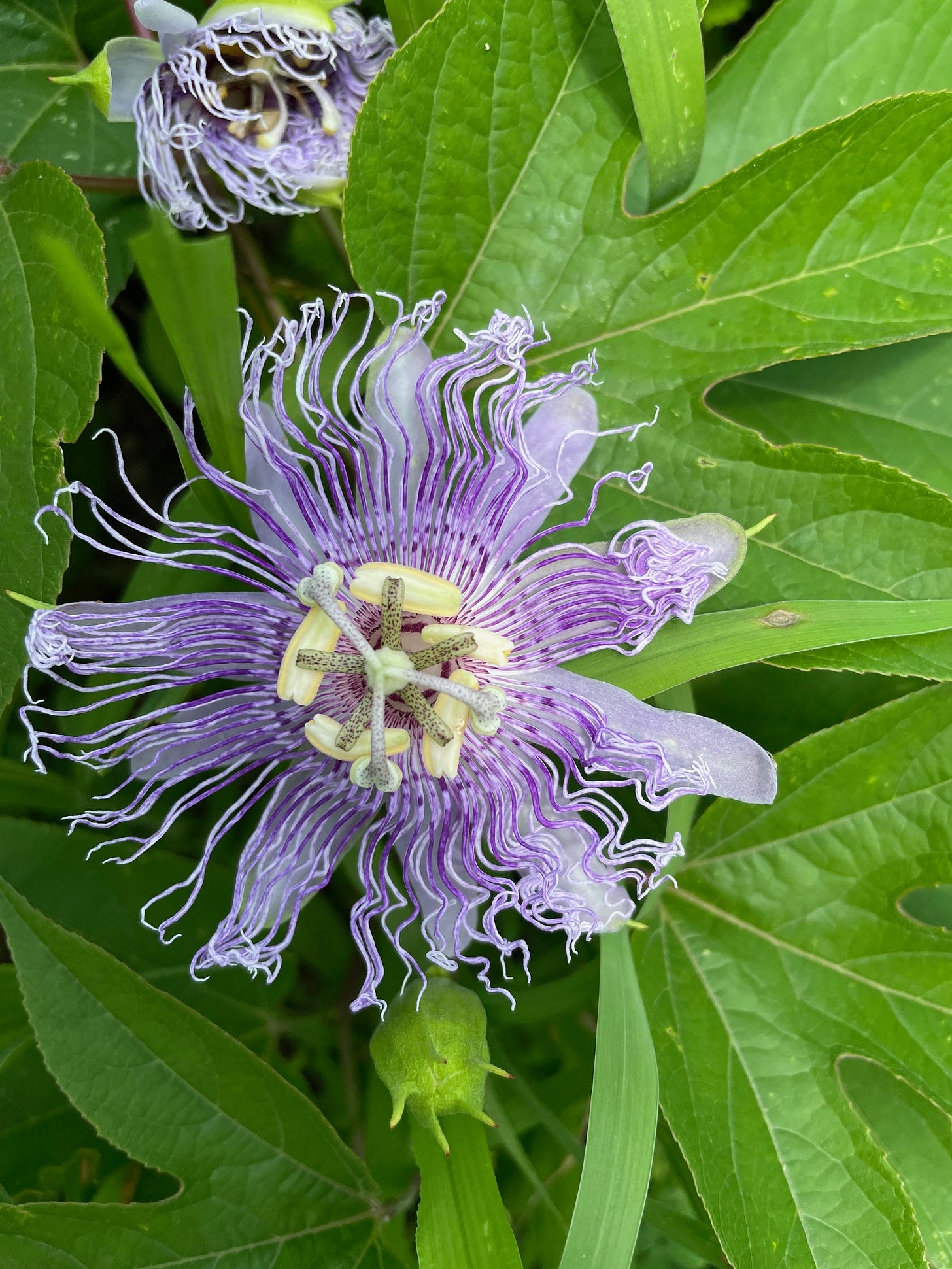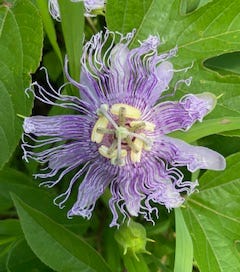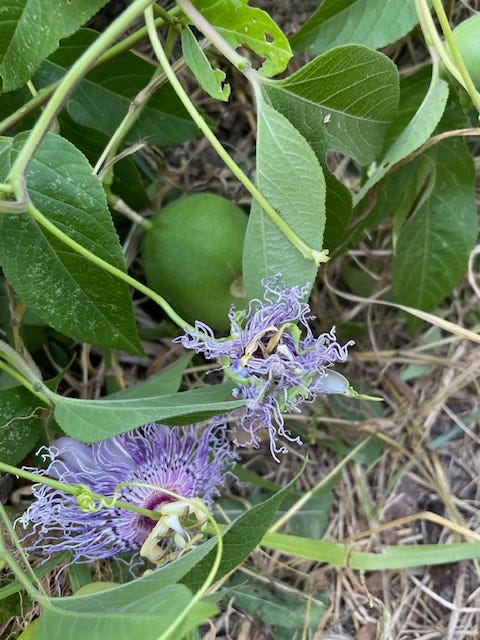In the midst of our excitement from the first pawpaw harvest at weedom, we’re bringing you another native of North America with a tropical flavor: Passionflower. The bloom itself looks like it’s from outer space, and both humans and the bugs seem to envision many different things in it. Like the pawpaw, passionflower grows wild in much of the Eastern U.S., but we purposely planted it at weedom. Many of you already know why we’d want this edible and medicinal weed, and by the end of this article, everyone else will too.
In 2023 we nicked a few seeds of ‘official’ Passionflower, Passiflora incarnata and planted them under grow lights. These, along with some hibiscus plants were moved outdoors to our mounded gardens by the swamp. Both of these species struggled in last year’s drought and appeared to die out. However in spring, we saw that the Passionflower rhizomes had been doing things underground, and a whole bunch of these viney plants rose from the depths to face another dry year. They climbed each other and other available weeds, flowered, and even produced a few fruits. After such effort on their part, we determined to help prop them up, and have constructed a semi-permanent trellis out of spare materials.
This rebel refugee from health care believes that most of the anti-anxiety and sleep aid offerings of pharma have too many liabilities, as does the marijuana weed that has been potentiated by selective breeding, and legalized in many locations. There’s a need to point people to milder and less brain bending alternatives, and passionflower is a good candidate. It’s able to produce mild anxiolytic and muscle relaxing effects, without placing the user into an impaired or compromised state. Anyone should have the option to get mellow without being blasted, or losing memories.
Let’s do the Botany.
Occupying much of the eastern U.S. in USDA hardiness zones 5 through 9, passion flower, Passiflora incarnata is one of about 500-900 species (depending on who you ask) from the family Passifloraceae. Passiflora edulis a.k.a. purple or yellow passionflower occupies warmer climates in South America, and is cultivated for fruit and pharmaceuticals. It’s used similarly to P. incarnata, and the chemistry is perhaps less thoroughly elucidated, but it’s catching up, due to big interest in such countries as Brazil.
Leaves of our P. incarnata arise alternately on smooth, hairless stems. They show palmate venation, and have 3 deeply cut lobes with fine toothed edges. Growing up to 6 inches wide, the leaves are a bit lighter green below, and semi-glossy green above. The youngest leaves and tips of stems are edible raw or cooked. These produce a succession of mild, indescribable flavors, ending in a general sweetness.

Passionflower has extra nectaries, right where the leaf attaches to the petiole, and at the base of sections of the flower bud which later become bracts of the flower. Ants and bees and various other insects feed at all these sites, with ants perhaps actively working to eliminate competitors. Juliet Blankespoor, over at the Chestnut School of Herbal Medicine, has stories about the ants picking off butterfly eggs, and tossing the caterpillars off of the passionflower leaves in their efforts to preserve the nectar supply.
Flowers (about 3 inches or 7-8cm in diameter) have 10 lighter shaded petals above which is a crown (corona) of filamentous strands with striped, darker purple pigmentation. A central structure (androgynophore) bears both male and female parts: a central bulb, the ovary, which has 3 styles and 3 stigmas (stigmata?) that curve downward. Also attached are 5 male stamens which curve so that the anthers likewise face downward. Passiflora got its genus name from a vision of the implements for the crucifixion of Christ imagined in the center of this flower, surely enhanced by the many stranded corona. In the 1600s, this vision propelled a live plant to be sent from the new world plant to Italy so that Pope Paul V could see it.


This little half minute vid of a bumble of weedom getting a buzz on, exemplifies the adaptive significance of the oddly structured flower with its 5 anthers bent with the pollen receptacles facing downward. The bumble bee gets a load of pollen brushed onto its fuzzy back as it feeds on the nectar, and carries it to the stigma on the next flower. This plant has some flowers in which only the male parts are functional, and others with both male and female functioning parts on the central structure.
The fruit of passionflower is classed as a berry. It ripens in the fall, becoming softer and yellowish. The riper it is, the sweeter it is, kind of like persimmon. The soft pulpy substance around the seeds is the edible part, which can be consumed raw, juiced, or made into jam. The seeds, which turn dark when mature, can be eaten, or spit out. If you choose to grow new plants from seed, they can be refrigerated, then nicked at the tip with a knife, and planted in warm soil in pots or outside. This plant likes well drained soil, and we can attest that it is fairly drought tolerant. It vines profusely and grows little tendrils from the stem that can grab and wind around any nearby support. Vines grow 2 meters or more in length.
A wide network of roots and rhizomes spread widely underground, sending up new shoots everywhere. Roots seem to be medicinally used part of the plant by the earliest immigrants to N. America, mostly for such things as wound care and treatment of inflammation or infection. In modern times, the aerial portions of the plant are most widely used.
First we’d like to suggest through chemistry that if people eat their fruits and vegetables, they’ll be happier and healthier in myriad ways. Then we’ll move back to some traditional herbalism.
Passiflora species contain an treasure trove of
flavonols- quercetin, kaempferol, (potent anti-inflammatory, anti-cancer, and/or anti-allergy compounds)
flavones - apigenin, luteolin and chrysin (a generally neuroprotective, antispasmodic, cardioprotective, anti-cancer, anti-inflammatory, anti-oxidant group of molecules).
flavonoids with a glucose molecule attached directly to the flavonoid core structure: vitexin, isovitexin (isomers related to apigenin) schaftoside, isoschaftoside, (related to apigenin), orientin and isoorientin (isomers related to luteolin), and swertisin.
indole alkaloids of beta-carboline type: harmalol, harmaline, harman, harmine, and harmol. This group of psychotropics and MAO inhibitors may be entirely missing from many prepared passiflora products, which could be an argument for growing your own.
Studies by anaesthesiologists have found passionflower to reduce the anxiety of those anticipating dental surgery similarly to midazolam (a fast acting benzodiazepine) but without the associated amnesia effect. Another clinical trial rated passionflower similarly to oxazepam for anxiety, but without the marked impairment of ability to operate heavy machinery. Beyond anxiety reduction, numerous studies of Passiflora incarnata have shown muscle relaxant, diastolic blood pressure reduction, antidiabetic effects, reduction of lipid absorption, and enhancement of clonidine effectiveness in the treatment of opiate and alcohol withdrawal.
Dietary fiber and other compounds found in the peel of the fruit have exhibited antidiabetic activity, and the flour obtained from dried fruit components has been used as a dietary aid to inhibit absorption of fats and carbohydrates. The flavonoid, shaftoside inhibits sodium glucose transporter-2 (SGLT-2) in the kidney, preventing reabsorption of excreted glucose, similarly to the “flozin” class of drugs for diabetes. Shaftoside also shows activity as a xanthine oxidase inhibitor, and therefore potential for the prevention and treatment of gout.
Apigenin and chrysin particularly have shown ability to bind to portions of the benzodiazepine portion of the GABA-A, receptor as a partial agonist. This, in part, explains the anxiety reducing effects of passionflower, and positions it as a replacement for the benzodiazepines while lacking their liabilities of memory impairment and habituation. Additional triterpene saponins are believed to contribute to antidepressant activity of this plant. Passionflower was compared to St. John’s wort in another clinical trial and found equally effective in addressing various symptoms of menopause such as hot flashes, palpitations, labile mood, depression, and sleeplessness.
Way back in the day (1930s) Mrs. Maude Grieve noted a “narcotic” principle in passiflora species which was called passiflorine in her Modern Herbal. No opiates are found so far, but in 1975, a novel cyclopropane triterpene glycoside was given that name “passiflorine”. Still you can see “passiflorine” products, which are extracts of passionflower and perhaps other plants, rather than that isolated compound.
When you’re making medicine, expect to experience more of the indole alkaloids and larger terpenoids in the strongest alcoholic tinctures. Fresh leaves and flowers can be tinctured in 95% ethanol in a 1:2 weight to volume ratio. Dried flowers can go into 50-60% ethanol in 1:5 ratio. Traditional dosing is 1-4 ml of tincture in the evening to relax for sleep, or use twice daily for other reasons. Dose for tea is a teaspoon of dried plant material per cup of water twice per day, or once in the evening. Traditional dose range of dried aerial plant parts by weight is 0.5 to 2 grams orally 2 to 4 times daily. There is little formal study of this plant in pregnant women or in children, but considerable traditional history of food use, and medicinal use by midwives and in children exists, with few reports of adverse effects in humans. Use of an alcoholic tincture on an isolated rat uterus was observed to cause contractions, and this has inspired cautions against use in pregnancy. There’s a report of prolonged QT interval and tachycardic episodes in a woman who took Passiflora. This has led to cautions about taking this herb with other QT prolonging meds. Sedating effects of passionflower may be additive with other such medications.
Passionflower is an herb with fairly neutral energetics, not too hot and not too cold. Despite this, herbalists don’t agree on the type or constitutions of people who would benefit most from its use. Southwestern herbal expert, Michael Moore felt that it could be applied to stronger, “mesomorphs” or “sthenic”, headstrong, hypertensive people to calm racing circular thoughts, address the high blood pressure, headaches and sleeplessness. Others specified it for exhaustion and debility from mental overactivity, stressing a greater appropriateness of addressing debility. Opinions abound. Perhaps if you can’t get a worry out of your head, passionflower tea will allow you relax, and find rest. It’s considered safe for kids, but might possibly cause paradoxical agitation in those below 4 years old if given in large doses.
This herb was traditionally given for infantile tetanus and for convulsive disorders of kids and adults. The benzodiazepine like activity of some of the components supplies an explanation for this usage, in addition to the muscle relaxant effects, which affect both smooth and skeletal muscle. Many herbalists reported that anti-seizure efficacy was greater if the herb was given sooner or as prevention. (This principle generally applies to anti-seizure meds from big Pharma too.) Reports of passiflora stopping very long standing (intractable) hiccups have been recorded, and it could definitely be considered instead of chlorpromazine, a.k.a. Thorazine, the common treatment offered by pharma.
Are you inspired to add this attractive, and versatile plant to your garden, or have you been way out ahead of Weedom concerning passionflower? Please share!
Bonus found online: Drlact.com is a reference evaluating alternative meds for safety in breastfeeding. It’s assembled by a bunch of docs and software engineers running an analytics program on assembled medical information. Since we generally agree with the results that it pops up, we consider it a useful tool giving an overview of which herbs are safe for a breastfed kid when the mom takes them.
Where We Dig
1. Wood M. The Earthwise Herbal. A Complete Guide to NEw World Medicinal Plants. North Atlantic Books; 2009. https://openlibrary.org/books/OL22552057M/The_earthwise_herbal.
2. Bhardwaj G, Vakani M, Srivastava A, et al. Swertisin, a novel SGLT2 inhibitor, with improved glucose homeostasis for effective diabetes therapy. Arch Biochem Biophys. 2021;710:108995. doi:10.1016/j.abb.2021.108995
3. Thayer S. Sam Thayer’s Field Guide to Edible Wild Plants of Eastern & Central North America. Forager’s Harvest; 2023.
4. Kim M, Lim HS, Lee HH, Kim TH. Role Identification of Passiflora Incarnata Linnaeus: A Mini Review. Journal of Menopausal Medicine. 2017;23(3):156-159. doi:10.6118/jmm.2017.23.3.156
5. DerMarderosian A, Buetler J. Review of Natural Products. 8th edition. Lippincott Williams & Wilkins; Facts and Comparisons; 2014. https://openlibrary.org/books/OL27960482M/Review_of_Natural_Products
6. Movafegh A, Alizadeh R, Hajimohamadi F, Esfehani F, Nejatfar M. Preoperative Oral Passiflora Incarnata Reduces Anxiety in Ambulatory Surgery Patients: A Double-Blind, Placebo-Controlled Study. Anesthesia & Analgesia. 2008;106(6):1728. doi:10.1213/ane.0b013e318172c3f9
7. Passionflower: 4 Benefits, Dosage, & Safety | The Botanical Institute. January 14, 2022. Accessed September 3, 2024. https://botanicalinstitute.org/passionflower/
8. de la Forêt R. Passionflower Uses and Plant Profile. Accessed September 3, 2024. https://www.learningherbs.com/blog/passionflower-uses
9. Blankespoor J. Passionflower - Ecology, Cultivation, Botany, and Medicinal and Edible Uses. Chestnut School of Herbal Medicine. August 10, 2012. Accessed September 2, 2024. https://chestnutherbs.com/passionflower-ecology-cultivation-botany-and-medicinal-and-edible-uses/
10. Bombardelli E, Bonati A, Gabetta B, Martinelli E, Mustich G, Danieli B. Passiflorine, a new glycoside from Passiflora edulis. Phytochemistry. 1975;14:2661-2665. doi:10.1016/0031-9422(75)85246-0
11. Miroddi M, Calapai G, Navarra M, Minciullo PL, Gangemi S. Passiflora incarnata L.: ethnopharmacology, clinical application, safety and evaluation of clinical trials. J Ethnopharmacol. 2013;150(3):791-804. doi:10.1016/j.jep.2013.09.047
12. Janda K, Wojtkowska K, Jakubczyk K, Antoniewicz J, Skonieczna-Żydecka K. Passiflora incarnata in Neuropsychiatric Disorders—A Systematic Review. Nutrients. 2020;12(12):3894. doi:10.3390/nu12123894
13. Heinzke AL, Pahl A, Zdrazil B, et al. Occurrence of “Natural Selection” in Successful Small Molecule Drug Discovery. J Med Chem. 2024;67(13):11226-11241. doi:10.1021/acs.jmedchem.4c00811
14. da Fonseca LR, Rodrigues R de A, Ramos A de S, et al. Herbal Medicinal Products from Passiflora for Anxiety: An Unexploited Potential. ScientificWorldJournal. 2020;2020:6598434. doi:10.1155/2020/6598434
15. Cech R. Growing Plant Medicine. Vol 2. Herbal Reeds, LLC; 2024.
16. Wang C, Xu FQ, Shang JH, et al. Cycloartane triterpenoid saponins from water soluble of Passiflora edulis Sims and their antidepressant-like effects. Journal of Ethnopharmacology. 2013;148(3):812-817. doi:10.1016/j.jep.2013.05.010
17. Rokhtabnak F, Ghodraty MR, Kholdebarin A, et al. Comparing the Effect of Preoperative Administration of Melatonin and Passiflora incarnata on Postoperative Cognitive Disorders in Adult Patients Undergoing Elective Surgery. Anesth Pain Med. 2017;7(1):e41238. doi:10.5812/aapm.41238
18. Nikolova K, Velikova M, Gentscheva G, et al. Chemical Compositions, Pharmacological Properties and Medicinal Effects of Genus Passiflora L.: A Review. Plants (Basel). 2024;13(2):228. doi:10.3390/plants13020228
19. Zanardi R, Carminati M, Fazio V, Maccario M, Verri G, Colombo C. Add-On Treatment with Passiflora incarnata L., herba, during Benzodiazepine Tapering in Patients with Depression and Anxiety: A Real-World Study. Pharmaceuticals (Basel). 2023;16(3):426. doi:10.3390/ph16030426








Just to clarify, is any passion fruit plant medicinal or is there a particular variety that is more medicinal. I have purple and yellow passion fruit in my garden. I don’t k ow much more about them than that. But I think I need the medicinal benefits in my life.
Thanks to Dawn Morgan for restacking